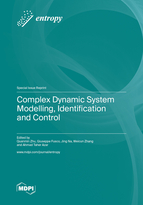Complex Dynamic System Modelling, Identification and Control
A special issue of Entropy (ISSN 1099-4300). This special issue belongs to the section "Complexity".
Deadline for manuscript submissions: closed (31 July 2021) | Viewed by 39293
Special Issue Editors
Interests: complex dynamic system identification and control
Special Issues, Collections and Topics in MDPI journals
Interests: control systems: theory and applications; smart grid control
Special Issues, Collections and Topics in MDPI journals
Interests: adaptive parameter estimation; system identification; intelligent control; adaptive control and application
Interests: adaptive control; self-tuning control; multiple model adaptive control; multiple model adaptive estimation; stability analysis
Special Issues, Collections and Topics in MDPI journals
2. Automated Systems & Soft Computing Lab (ASSCL), Prince Sultan University, Riyadh 12435, Saudi Arabia
3. Faculty of Computers and Artificial Intelligence, Benha University, Benha 13518, Egypt
Interests: artificial intelligence; robotics; control theory and applications; machine learning; computational intelligence
Special Issues, Collections and Topics in MDPI journals
Special Issue Information
Dear Colleagues,
Systems are naturally or purposely formed with functional components and connection structures. The complicities could be induced from nonlinearity, dynamics, time delay, uncertainties, disturbances, irreversible processes, and those characteristics generally explained in the other literature.
Modeling is an innate intuition for humans to find rules or mechanisms of phenomena (a process/plant in a human-made system or a natural system such as earth's global climate, organisms, and the human brain) This is generally fitted with the journal titled research – Entropy, as the idea of entropy provides a mathematical way to encode/model the intuitive notion of which processes are obviously complex due to the irreversible characteristics, even though they would not violate the fundamental law of conservation of energy
There are two predominant approaches to establish models, principle (e.g., information theory, statistic physics, statistical mechanics, etc.) based analytical equations and data (measured and simulated) driven input/output fitted set of regression numerical polynomials (most commonly called identification).
Control is a way to improve a system behavior/performance by adding additional functional components and revising system structure to form a closed-loop framework with adaptation and robustness to the uncertainties.
Accordingly, modeling, identification, and control (MIC) is a cross-discipline from all engineering (human-made) systems to all the natural scientific research discoveries.
This Special Issue is encouraging those emerging insights and approaches to provide concise/effective solutions in complex dynamic system modeling, identification, and control. The philosophy embedded in the S.I. is to seek simplicity (solutions) from complicity (problems).
This Special Issue is a forum for presenting new and improved insight, methodologies, and techniques of MIC for complex systems that are challenging for research and (potential) significant for a wide range of applications in the real-world natural and engineering domains. Fundamentally, the papers should justify why the works have not been undertaken by the other colleagues and what the bottleneck issues have been the barriers for such research progression and applications.
Prof. Dr. Quan Min Zhu
Prof. Giuseppe Fusco
Prof. Dr. Jing Na
Dr. Weicun Zhang
Prof. Dr. Ahmad Taher Azar
Guest Editors
Manuscript Submission Information
Manuscripts should be submitted online at www.mdpi.com by registering and logging in to this website. Once you are registered, click here to go to the submission form. Manuscripts can be submitted until the deadline. All submissions that pass pre-check are peer-reviewed. Accepted papers will be published continuously in the journal (as soon as accepted) and will be listed together on the special issue website. Research articles, review articles as well as short communications are invited. For planned papers, a title and short abstract (about 100 words) can be sent to the Editorial Office for announcement on this website.
Submitted manuscripts should not have been published previously, nor be under consideration for publication elsewhere (except conference proceedings papers). All manuscripts are thoroughly refereed through a single-blind peer-review process. A guide for authors and other relevant information for submission of manuscripts is available on the Instructions for Authors page. Entropy is an international peer-reviewed open access monthly journal published by MDPI.
Please visit the Instructions for Authors page before submitting a manuscript. The Article Processing Charge (APC) for publication in this open access journal is 2600 CHF (Swiss Francs). Submitted papers should be well formatted and use good English. Authors may use MDPI's English editing service prior to publication or during author revisions.
Keywords
- complex human-made and natural systems
- system identification
- nonlinear adaptive control
- robotic systems
- artificial intelligence for MIC
- immerging methodologies and algorithms for MIC
- entropy-oriented MIC
- case studies
- and applications











